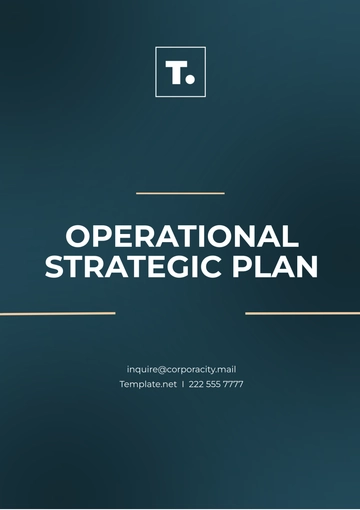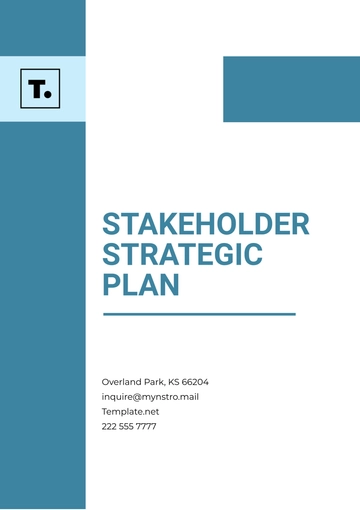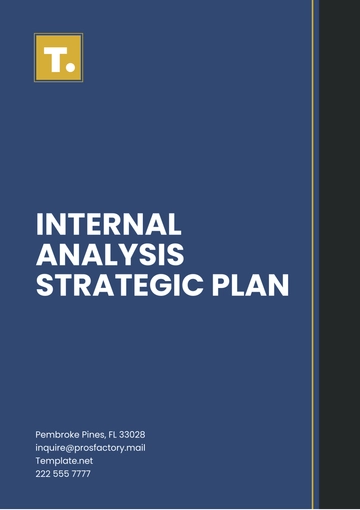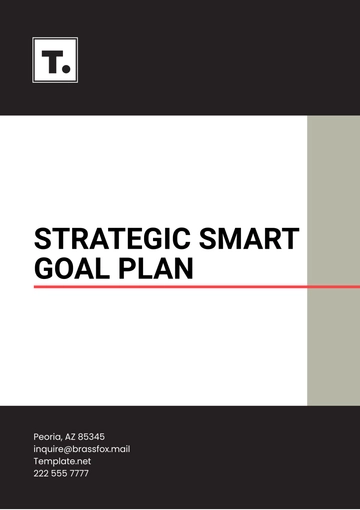Free Telecommunication Strategic Plan

I. Executive Summary
A. Overview of the Organization’s Vision and Mission
[Your Company Name] envisions becoming the global leader in next-generation telecommunication services, driving the digital transformation of industries worldwide. Our mission is to provide ultra-reliable, high-speed, and sustainable connectivity solutions that empower individuals, businesses, and governments to thrive in an increasingly digital world. By 2050, we aim to deliver unparalleled customer experiences through innovations in 6G, AI-powered networks, and quantum communication technologies.
B. High-Level Objectives of the Strategic Plan
The primary objective of our 2050 strategic plan is to ensure that [Your Company Name] remains at the forefront of the telecom industry by advancing technological innovation, expanding our global network footprint, and providing sustainable connectivity solutions. We will focus on enhancing the customer experience through seamless integration of AI, IoT, and edge computing, while continuously reducing environmental impact.
C. Key Drivers of Change in the Industry
Technological advancements, such as the advent of 6G, AI-enhanced network management, and quantum communications, will revolutionize the telecom industry. Additionally, the growing demand for ultra-low-latency services, driven by industries like autonomous vehicles and telemedicine, will push the need for robust, scalable infrastructure. Regulatory pressures on sustainability, data privacy, and cyber resilience will also shape our strategic direction.
D. Summary of Proposed Goals and Initiatives
Our goals for 2050 include the global rollout of 6G infrastructure, achieving net-zero emissions in network operations, and pioneering the adoption of quantum-safe encryption for data protection. Initiatives will focus on advancing smart city connectivity, expanding fiber networks to underserved regions, and leveraging AI to predict and prevent network failures before they occur.
II. Company Vision, Mission, and Values
A. Vision Statement
To build a connected world where everyone, everywhere can access the services and technologies they need to achieve their fullest potential, powered by [Your Company Name]'s innovative and sustainable telecom solutions.
B. Mission Statement
We empower the world’s communities and enterprises by delivering transformative connectivity solutions through cutting-edge technologies, operational excellence, and a customer-first mindset.
C. Core Values
Innovation: We continuously invest in next-generation technologies and disruptive solutions.
Sustainability: We are committed to building environmentally friendly networks that support global sustainability efforts.
Customer Centricity: We put customers at the heart of everything we do, delivering solutions that are reliable, accessible, and user-friendly.
Integrity: We uphold the highest standards of ethics and transparency in all of our business dealings.
D. Alignment of Strategic Plan with Corporate Goals
The 2050 strategic plan is designed to align closely with our long-term corporate goals of technological leadership, market expansion, and environmental responsibility. Each initiative is crafted to support our vision of being a future-ready telecom company that thrives by enabling global digital transformation.
III. Market and Industry Analysis
A. Current Market Landscape
The global telecommunications market is rapidly evolving, with significant advancements in network technologies and an increasing shift toward digital and cloud-based services. In 2050, the market will be dominated by the integration of AI, 6G, and quantum technologies, which will provide exponentially higher speeds and ultra-low latency. Key competitors are also investing heavily in these technologies, which will lead to intense competition and innovation in the coming decades.
B. Customer Needs and Trends
Customers in 2050 will demand seamless, instantaneous connectivity, even in remote or underserved areas. There will be a growing expectation for personalized services powered by AI, where network traffic adapts in real time to user demands. The need for highly secure communication, especially in critical infrastructure, will also escalate, leading to a significant demand for quantum-safe encryption.
C. Regulatory and Compliance Considerations
In 2050, telecommunications companies will face stricter regulatory requirements around data privacy, cybersecurity, and sustainability. Governments will enforce rigorous emissions reduction standards for telecom networks, and quantum encryption will become a legal requirement for all sensitive communications. Compliance with these regulations will be vital to maintaining trust and operating internationally.
D. Emerging Technological Trends
Key technological advancements driving change include:
6G Networks: Hyperconnectivity and ultra-reliable low-latency communication (URLLC).
AI-Powered Networks: Self-healing, self-optimizing networks.
Quantum Communication: Secure data transmission through quantum key distribution (QKD).
Edge Computing: Reducing latency and improving real-time data processing.
IV. Technological and Infrastructure Strategy
A. Current Network and Systems Overview
[Your Company Name]’s current network infrastructure supports 5G connectivity across major urban centers globally. However, the growth in IoT devices and the rise of autonomous systems necessitate a transition to 6G to handle the higher bandwidth and latency requirements. Our network already incorporates AI-based traffic management, but expansion of quantum-safe encryption and edge computing will be crucial to meet future demands.
B. Technological Upgrades and Innovations
In 2050, we will complete the global deployment of 6G, offering 1,000 times the speed and 10 times the capacity of 5G. Our network will also leverage AI-enhanced automation for self-management and predictive maintenance, significantly reducing downtime. Furthermore, we will adopt quantum communication for encryption and data transmission to secure sensitive information.
C. Infrastructure Expansion
We will expand fiber optic networks to all major cities and underserved rural regions, ensuring universal access to high-speed internet. New data centers will be established in regions with low environmental footprints, utilizing renewable energy sources to power them. Additionally, edge computing nodes will be deployed to support real-time data processing for applications such as autonomous driving and smart cities.
D. Cybersecurity and Network Resilience
Our cybersecurity strategy will include quantum-safe encryption and AI-driven threat detection. To ensure network resilience, we will implement multi-layered backup systems and decentralized edge networks to minimize the impact of localized failures. Regular security audits and compliance with international data protection standards will be a priority.
V. Strategic Goals and Objectives
A. Long-Term Goals
Achieve global 6G coverage, connecting [00]% of the world’s population by 2050.
Reduce operational carbon footprint by [00]% through renewable energy-powered data centers and network operations.
Lead the industry in quantum-safe encryption and secure communications.
B. Short-Term Objectives (1-3 Years)
Deploy 6G pilot networks in select cities for early adopter industries.
Launch AI-powered customer service platforms that provide personalized experiences.
Establish partnerships with leading quantum computing firms to integrate quantum encryption into our network.
C. Key Performance Indicators (KPIs)
KPI | Target for 2050 | Current Status |
|---|---|---|
6G Network Coverage | 95% Global Coverage | 40% |
Carbon Emissions Reduction | 90% Reduction | 40% |
Quantum Encryption Adoption | 100% of Sensitive Traffic | 0% |
Customer Satisfaction (NPS) | 90%+ | 70% |
VI. Financial Strategy and Budgeting
A. Capital Investment Requirements
The total capital investment required for technological upgrades, including 6G rollout, fiber infrastructure expansion, and quantum encryption systems, is projected to be $[00] billion over the next 25 years. Annual budgets will allocate [00]% of revenue to R&D and infrastructure development.
B. Revenue Growth and Monetization Strategies
We will introduce new revenue streams through premium services for businesses, including private 6G networks and IoT solutions. Additionally, by offering cloud-based telecom services and edge computing infrastructure as a service, we aim to expand our enterprise clientele.
C. Cost Management and Efficiency Initiatives
Our operational cost reduction will be achieved by automating network management, reducing energy consumption through AI optimization, and streamlining supply chains through blockchain technology for real-time monitoring.
VII. Customer Experience and Market Positioning
A. Customer Acquisition Strategies
We will focus on targeted marketing for the early adoption of 6G services, offering customized business solutions for industries such as healthcare, transportation, and manufacturing. Additionally, we will launch digital platforms that provide seamless onboarding and instant connectivity services.
B. Customer Retention and Loyalty Programs
To retain customers, we will introduce a loyalty program that rewards long-term users with discounted rates on next-gen services, along with exclusive access to new features. We will also ensure 24/7 AI-powered support and proactive service monitoring.
C. Brand Positioning and Competitive Differentiation
Our brand will be positioned as the most reliable, secure, and innovative telecom provider, with a focus on sustainability and quantum-safe communication. We will differentiate ourselves through a strong commitment to data privacy and cutting-edge technology, providing unmatched service reliability.
VIII. Implementation Plan and Timeline
A. Actionable Roadmap for the Strategic Plan
The implementation of our 2050 strategic plan will occur in two phases:
Phase 1 (2030-2040): | Expansion of 6G networks globally, scaling fiber infrastructure to rural and underserved areas, and deep integration of AI and quantum encryption into core systems. |
Phase 2 (2040-2050) | Full global deployment of 6G, achieving 95% population coverage, and operationalizing the global quantum-safe network. |
B. Resource Allocation and Responsibilities
Key responsibilities will be assigned to the following departments:
Network Engineering: Lead the deployment and scaling of 6G and fiber networks.
R&D and Innovation: Focus on AI integration, edge computing, and quantum communication systems.
Operations: Oversee the implementation of sustainability measures and operational efficiencies.
Marketing and Customer Experience: Drive adoption and loyalty programs, ensuring high customer satisfaction.
C. Monitoring and Adjustment Mechanisms
Progress Reviews
Quarterly and annual reviews will assess progress towards key milestones, ensuring that the timelines and objectives are met.
Adjustments
If the market or technological landscape changes, the strategic plan will be adjusted to reflect new opportunities or challenges, with specific focus on evolving customer demands, new regulations, and technological advancements.
IX. Risk Management and Contingency Planning
A. Identification of Key Risks
Technological Risks
The rollout of 6G and quantum communications may face unforeseen challenges, such as hardware limitations or cybersecurity threats from emerging technologies.
Market Risks
Intense competition and changes in customer preferences could threaten market share. Global economic downturns may also reduce demand for premium services.
Operational Risks
Supply chain disruptions for critical components, such as quantum processors, could delay network deployments. Furthermore, failure to meet sustainability goals could damage brand reputation.
B. Mitigation Strategies
Technological Risks
Continuous R&D investment, collaboration with leading tech firms, and cybersecurity frameworks will mitigate potential technological failures.
Market Risks
Diversifying the portfolio by offering both consumer-focused and enterprise solutions will help spread risk. Early adoption programs and flexible pricing strategies will increase market penetration.
Operational Risks
Strengthening relationships with multiple suppliers and adopting a flexible, decentralized approach to infrastructure will reduce reliance on any single supplier. A contingency plan will be in place for disaster recovery.
C. Crisis Management and Recovery Plans
In the event of network outages or cybersecurity breaches, [Your Company Name] will initiate a multi-tiered response protocol, including:
Immediate communication with customers, regulators, and stakeholders.
Backup network systems and rapid restoration through automated recovery processes.
Post-crisis analysis to identify root causes and improve future resilience.
X. Monitoring, Reporting, and Continuous Improvement
A. Performance Monitoring Tools and Systems
Our network and operational performance will be monitored in real-time using advanced AI-based monitoring tools that track latency, network health, and customer usage patterns. Additionally, predictive analytics will be used to forecast network demand and optimize performance. Key tools will include:
Network Performance Dashboards: Providing real-time data on network usage, issues, and efficiency.
Customer Experience Analytics: Analyzing feedback and service metrics to proactively resolve issues before customers notice.
Sustainability Monitoring: Real-time tracking of carbon emissions and resource consumption to ensure we meet sustainability targets.
B. Reporting and Analytics
Regular reports will be generated and distributed to senior management, including:
Quarterly Reports: Highlighting progress on key performance indicators (KPIs), such as customer growth, operational efficiency, and sustainability achievements.
Annual Reports: Providing a comprehensive review of the year’s accomplishments, challenges, financial performance, and strategic adjustments.
KPI Dashboards: Accessible to stakeholders and leadership for real-time data on project and operational success.
C. Continuous Improvement Strategies
Feedback Loops: Customer feedback will be integrated into continuous product and service development, ensuring offerings are always aligned with market needs.
AI-driven Process Optimization: Leveraging machine learning algorithms to automate and continuously improve network management and customer service operations.
Innovation Cycles: Regular innovation workshops and strategic reviews to evaluate emerging technologies and integrate the best solutions into the business.
- 100% Customizable, free editor
- Access 1 Million+ Templates, photo’s & graphics
- Download or share as a template
- Click and replace photos, graphics, text, backgrounds
- Resize, crop, AI write & more
- Access advanced editor
Keep your telecommunication strategy on track with the Telecommunication Strategic Plan Template from Template.net. This fully editable and customizable template allows you to tailor every section to suit your business needs. With the intuitive AI Editor Tool, you can easily adjust content, update goals, and ensure your plan aligns with future tech advancements.





























